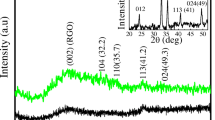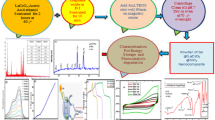Abstract
NiMoS2 is a promising material for various functional applications and highly compatible with GO to make hybrid nanocomposites with excellent characteristics for supercapacitor electrode material. Deposition of NiMoS2 was achieved on the rGO(reduced Graphene Oxide) surface to form a NiMoS2−rGO nanocomposite by the method of the facile hydrothermal synthesis process. XRD pattern shows the crystalline nature of composites. Raman and EPMA result interpreting the composites formation and elements compositions, respectively. The sheet-like morphology of rGO was found in the composites by FESEM images. Particles distribution was confirmed by HR-TEM. The electrochemical properties of the pure NiMoS2 and NiMoS2–rGO composites have been studied by cyclic voltammetry analysis. The results revealed that the NiMoS2/5% rGO nanocomposites exhibit high specific capacitance compared to pure NiMoS2 due to the synergistic effects of NiMoS2 and rGO in the composite material. The photocatalytic behavior of the prepared nanocomposites for dye degradation was tested. The quantity of rGO has significantly improved the photocatalytic behavior of NiMoS2/rGO composites. The studies on degradation mechanism, the N2 adsorption/desorption isotherms, pore size distribution behavior and % of removal of MB reveal the enhanced photocatalytic performance of sysnthesised composites.












Similar content being viewed by others
References
Miller JR, Simon P (2008) Electrochemical capacitors for energy management. Science. https://doi.org/10.1126/science.1158736
González A, Goikolea E, Barrena JA, Mysyk R (2016) Review on supercapacitors: technologies and materials. Renew Sustain Energy Rev. https://doi.org/10.1016/j.rser.2015.12.249
Reddy ALM, Gowda SR, Shaijumon MM, Ajayan PM (2012) Hybrid nanostructures for energy storage applications. Adv Mater. https://doi.org/10.1002/adma.201104502
García P, Torreglosa JP, Fernández LM, Jurado F (2013) Control strategies for high-power electric vehicles powered by hydrogen fuel cell, battery and supercapacitor. Expert Syst Appl. https://doi.org/10.1016/j.eswa.2013.02.028
Song Z, Hou J, Hofmann H, Li J, Ouyang M (2017) Sliding-mode and Lyapunov function-based control for battery/supercapacitor hybrid energy storage system used in electric vehicles. Energy. https://doi.org/10.1016/j.energy.2017.01.098
Maiaugree W, Tangtrakarn A, Lowpa S, Ratchapolthavisin N, Amornkitbamrung V (2015) Facile synthesis of bilayer carbon/Ni3S2 nanowalls for a counter electrode of dye-sensitized solar cell. Electrochim Acta. https://doi.org/10.1016/j.electacta.2015.06.051
Jiaqin Y, Duan X, Guo W, Li Di, Zhang H, Zheng W (2014) Electrochemical performances investigation of NiS/rGO composite as electrode material for supercapacitors. Nano Energy. https://doi.org/10.1016/j.nanoen.2014.02.006
Zhang Z, Zhao C, Min S, Qian X (2014) A facile one-step route to RGO/Ni3S2 for high-performance supercapacitors. Electrochim Acta. https://doi.org/10.1016/j.electacta.2014.08.038
Yang W, Ni M, Ren X, Tian Y, Li N, Yuefeng Su, Zhang X (2015) Graphene in supercapacitor applications. Curr Opin Colloid Interface Sci. https://doi.org/10.1016/j.cocis.2015.10.009
Sun Y, Zhang W, Li D, Gao L, Hou C, Zhang Y, Liu Y (2015) Facile synthesis of MnO2/rGO/Ni composite foam with excellent pseudocapacitive behavior for supercapacitors. J Alloys Compd. https://doi.org/10.1016/j.jallcom.2015.07.212
Nandi D, Mohan VB, Bhowmick AK, Bhattacharyya D (2020) Metal/metal oxide decorated graphene synthesis and application as supercapacitor: a review. J Mater Sci. https://doi.org/10.1007/s10853-020-04475-z
Chou S-W, Lin J-Y (2013) Cathodic deposition of flaky nickel sulfide nanostructure as an electroactive material for high-performance supercapacitors. J Electrochem Soc. https://doi.org/10.1149/2.078304jes
Yong H, Li X, Wang C (2016) Nitrogen-doped graphene/sulfur composite as cathode material for room-temperature sodium-sulfur battery application. Electrochem Soc. https://doi.org/10.1149/MA2016-01/5/480
Yang T, Ruiyi Li, Xiaohuan L, Li Zaijun Gu, Zhiguo WG, Junkang L (2016) Nitrogen and sulphur-functionalized multiple graphene aerogel for supercapacitors with excellent electrochemical performance. Electrochim Acta. https://doi.org/10.1016/j.electacta.2015.11.043
Jiaqin Y, Duan X, Qin Q, Zheng W (2013) Solvothermal synthesis of hierarchical flower-like β-NiS with excellent electrochemical performance for supercapacitors. J Mater Chem A. https://doi.org/10.1039/C3TA11167A
Wei Z, Zheng J-L, Yue Y-H, Guo L (2015) Highly stable rGO-wrapped Ni3S2 nanobowls: Structure fabrication and superior long-life electrochemical performance in LIBs. Nano Energy. https://doi.org/10.1016/j.nanoen.2014.11.022
Jayachandiran J, Yesuraj J, Arivanandhan M, Raja A, Austin Suthanthiraraj S, Jayavel R, Nedumaran D (2018) Synthesis and electrochemical studies of rGO/ZnO nanocomposite for supercapacitor application. J Inorg Organomet Polym Mater. https://doi.org/10.1007/s10904-018-0873-0
Liu Y, Zhao D, Liu H, Umar A, Xiang Wu (2018) High performance hybrid supercapacitor based on hierarchical MoS2/Ni3S2 metal chalcogenide. Chin Chem Lett. https://doi.org/10.1016/j.cclet.2018.12.024
Manikandan R, Justin Raj C, Nagaraju G, Velayutham R, Moulton SE, Puigdollers J, Kim BC (2021) Selenium enriched hybrid metal chalcogenides with enhanced redox kinetics for high-energy density supercapacitors. Chem Eng J. https://doi.org/10.1016/j.cej.2021.128924
Hu X, Zhang W, Liu X, Mei Y, Huang Y (2015) Nanostructured Mo-based electrode materials for electrochemical energy storage. Chem Soc Rev. https://doi.org/10.1039/C4CS00350K
Rao CNR, Gopalakrishnan K, Maitra U (2015) Comparative study of potential applications of graphene, MoS2, and other two dimensional materials in energy devices, sensors, and related areas. ACS Appl Mater Interfaces. https://doi.org/10.1021/am509096x
Beidaghi M, Gogotsi Y (2014) Capacitive energy storage in microscale devices: recent advances in design and fabrication of microsupercapacitors. Energy Environ Sci. https://doi.org/10.1039/C3EE43526A
Cao L, Yang S, Gao W, Liu Z, Gong Y, Ma L, Shi G, Lei S, Zhang Y, Zhang S, Vajtai R, Ajayan PM (2013) Direct laserpatterned micro-supercapacitors from paintable MoS2 films. Small. https://doi.org/10.1002/smll.201203164
Huang P, Lethien C, Pinaud S, Brousse K, Laloo R, Turq V, Respaud M, Demortiere A, Daffos B, Taberna PL, Chaudret B, Gogotsi Y, Simon P (2016) On-chip and freestanding elastic carbon films for micro-supercapacitors. Science. https://doi.org/10.1126/science.aad3345
Yun J, Song C, Lee H, Park H, Jeong YR, Kim JW, Jin SW, Oh SY, Sun L, Zi G, Ha JS (2018) Stretchable array of highperformance micro-supercapacitors charged with solar cells for wireless powering of an integrated strain sensor. Nano Energy. https://doi.org/10.1016/j.nanoen.2018.05.017
Huang Y, Yan C, Shi X, Zhi W, Li Z, Yan Y, Zhang M, Cao G (2018) Ni0.85 Co0.15WO4 nanosheet electrodes for supercapacitors with excellent electrical conductivity and capacitive performance. Nano Energy. https://doi.org/10.1016/j.nanoen.2018.03.082
Luo S, Shen Y, Yu S, Wan Y, Liao W, Sun R, Wong C (2017) Construction of a 3D-BaTiO3 network leading to significantly enhanced dielectric permittivity and energy storage density of polymer composites. Energy Environ Sci. https://doi.org/10.1039/C6EE03190K
Wang C, Guan Z, Shen Y, Yu S, Fu X-Z, Sun R, Wong C-P (2018) Shape-controlled synthesis of CoMoO4@Co15Ni15S4 hybrids with rambutan-like structure for high-performance all-solid-state supercapacitors. Chem Eng J. https://doi.org/10.1016/j.cej.2018.03.160
Li Z, Huang T, Gao W, Xu Z, Chang D, Zhang C, Gao C (2017) Hydrothermally activated graphene fiber fabrics for textile electrodes of supercapacitors. ACS Nano. https://doi.org/10.1021/acsnano.7b05092
Jiang Q, Kurra N, Xia C, Alshareef HN (2017) Hybrid Microsupercapacitors with vertically scaled 3D current collectors fabricated using a simple cut-and-transfer strategy. Adv Energy Mater. https://doi.org/10.1002/aenm.201601257
Wu Z-S, Parvez K, Winter A, Vieker H, Liu X, Han S, Turchanin A, Feng X, Muellen K (2014) Layer-by-layer assembled heteroatom-doped graphene films with ultrahigh volumetric capacitance and rate capability for micro-supercapacitors. Adv Mater. https://doi.org/10.1002/adma.201401228
Wu J, Shi X, Song W, Ren H, Tan C, Tang S, Meng X (2018) Hierarchically porous hexagonal microsheets constructed by wellinterwoven MCo2S4 (M = Ni, Fe, Zn) nanotube networks via twostep anion-exchange for high-performance asymmetric supercapacitors. Nano Energy. https://doi.org/10.1016/j.nanoen.2018.01.024
Ohtani B (2010) Photocatalysis A to Z—What we know and what we do not know in a scientific sense. J Photochem Photobiol C. https://doi.org/10.1016/j.jphotochemrev.2011.02.001
Junyu Z, Gen L, Hong GL, Shi GS (2020) Tracking the atomic pathways of Pt3Ni-Ni(OH)2 core-shell structures at the gas-liquid interface by in-situ liquid cell TEM. Sci China Chem. https://doi.org/10.1007/s11426-019-9663-8
Jing L, Gary H, Junqing Y, Shengzhong FL (2021) Metal-doped Mo2C (metal = Fe Co, Ni, Cu) as catalysts on TiO2 for photocatalytic hydrogen evolution in neutral solution. Chin J Catal. https://doi.org/10.1016/S1872-2067(20)63589-6
Mengmeng Z, Kai Z, Jinyan X, Yi W, Chao H, Weijie L, Gang C (2020) 1D/2D WO3 nanostructure coupled with nanoparticulate CuO cocatalyst for enhancing solardriven CO2 photoreduction: The impact of the crystal facet. Sustain Energy Fuel. https://doi.org/10.1039/D0SE00034E
Rongchen S, Kelin H, Aiping Z, Neng L, Yun HN, Peng Z, Jun H, Xin L (2021) In-situ construction of metallic Ni3C@Ni core–shell cocatalysts over g-C3N4 nanosheets for shell-thickness-dependent photocatalytic H2 production. Appl Catal B Environ. https://doi.org/10.1016/j.apcatb.2021.120104
Miao MF, Jun XS, Xiang-G H, Jin YW, Wei C (2020) Direct Z-scheme CdFe2O4/g-C3N4 hybrid photocatalysts for highly efficient ceftiofur sodium photodegradation. J Mater Sci Technol. https://doi.org/10.1016/j.jmst.2020.01.054
Zizhan L, Rongchen S, Yun HN, Peng Z, Quanjun X, Xin L (2020) A review on 2D MoS2 cocatalysts in photocatalytic H2 production. J Mater Sci Technol. https://doi.org/10.1016/j.jmst.2020.04.032
Cai W, Lai T, Lai J, Xie H, Ouyang L, Ye J, Chengzhong Yu (2016) Transition metal sulfides grown on graphene fibers for wearable asymmetric supercapacitors with high volumetric capacitance and high energy density. Sci Rep. https://doi.org/10.1038/srep26890
Liu W, Niu H, Yang J, Cheng K, Ye Ke, Zhu K, Wang G, Cao D, Yan J (2018) Ternary transition metal sulfides embedded in graphene nanosheets as both the anode and cathode for high-performance asymmetric supercapacitors. Chem Mater. https://doi.org/10.1021/acs.chemmater.7b04976
Huang K-J, Zhang J-Z, Shi G-W, Liu Y-M (2014) Hydrothermal synthesis of molybdenum disulfide nanosheets as supercapacitors electrode material. Electrochim Acta. https://doi.org/10.1016/j.electacta.2014.04.007
Wu Z, Li B, Xue Y, Li J, Zhang Y, Gao F (2015) Fabrication of defect-rich MoS2 ultrathin nanosheets for application in lithium-ion batteries and supercapacitors. J Mater Chem A. https://doi.org/10.1039/C5TA04549E
Ji H, Liu C, Wang T, Chen J, Mao Z, Zhao J, Hou W, Yang G (2015) Porous hybrid composites of few-layer MoS2 nanosheets embedded in a carbon matrix with an excellent supercapacitor electrode performance. Small. https://doi.org/10.1002/smll.201502355
Javed MS, Dai S, Wang M, Guo D, Chen L, Wang X, Hu C, Xi Y (2015) High performance solid state flexible supercapacitor based on molybdenum sulfide hierarchical nanospheres. J Power Sources. https://doi.org/10.1016/j.jpowsour.2015.03.079
Shang M, Du C, Huang H, Mao J, Liu P, Song W (2018) Direct electrochemical growth of amorphous molybdenum sulfide nanosheets on Ni foam for high-performance supercapacitors. J Colloid Interface Sci. https://doi.org/10.1016/j.jcis.2018.07.127
Ilanchezhiyan P, Mohan Kumar G, Kang TW (2015) Electrochemical studies of spherically clustered MoS2 nanostructures for electrode applications. J Alloys Compd. https://doi.org/10.1016/j.jallcom.2015.02.082
Zhang Y, Sun W, Rui X, Li B, Tan HT, Guo G, Madhavi S, Zong Y, Yan Q (2015) One-pot synthesis of tunable crystalline Ni3S4 @Amorphous MoS2 core/shell nanospheres for high-performance supercapacitors. Small. https://doi.org/10.1002/smll.201403772
Wang X, Ding J, Yao S, Wu X, Feng Q, Wang Z, Geng B (2014) High supercapacitor and adsorption behaviors of flower-like MoS2 nanostructures. J Mater Chem A. https://doi.org/10.1039/C4TA03044C
Wang H, Yuan H, Sae Hong S, Li Y, Cui Y (2015) Physical and chemical tuning of two-dimensional transition metal dichalcogenides. Chem Soc Rev. https://doi.org/10.1039/C4CS00287C
Xiao K, Li JW, Chen G-F, Liu Z-Q, Li N, Su Y-Z (2014) Amorphous MnO2 supported on 3D-Ni nanodendrites for large areal capacitance supercapacitors. Electrochim Acta. https://doi.org/10.1039/D1QM00128K
Jiang Z, Lu W, Li Z, Ho KH, Li X, Jiao X, Chen D (2014) Synthesis of amorphous cobalt sulfide polyhedral nanocages for high performance supercapacitors. J Mater Chem A. https://doi.org/10.1039/C3TA14430E
Hummers Jr, WS, Offeman RE (1958) Preparation of graphitic oxide. J Am Chem Soc 1339–1339. https://doi.org/10.1021/ja01539a017
Satheesh K, Jayavel R (2013) Synthesis and electrochemical properties of reduced graphene oxide via chemical reduction using thiourea as a reducing agent. Mater Lett. https://doi.org/10.1016/j.matlet.2013.09.044
Geim AK, Novoselov KS (2007) The rise of grapheme. Nat Mater. https://doi.org/10.1038/nmat1849
Dikin DA, Stankovich S, Zimney EJ, Piner RD, Dommett GHB, Evmenenko G, Nguyen ST, Ruoff RS (2007) Preparation and characterization of graphene oxide. Nature. https://doi.org/10.1038/nmat1849
Author information
Authors and Affiliations
Corresponding author
Ethics declarations
Conflict of interest
On behalf of all authors, the corresponding author states that there is no conflict of interest.
Additional information
Publisher's Note
Springer Nature remains neutral with regard to jurisdictional claims in published maps and institutional affiliations.
Rights and permissions
About this article
Cite this article
Ganeshkumar, A., Pazhanivel, K., Ramadoss, N. et al. Facile synthesis and characteristics of NiMoS2/rGO nanocomposites for energy and environmental application. Carbon Lett. 32, 753–765 (2022). https://doi.org/10.1007/s42823-021-00305-7
Received:
Revised:
Accepted:
Published:
Issue Date:
DOI: https://doi.org/10.1007/s42823-021-00305-7




